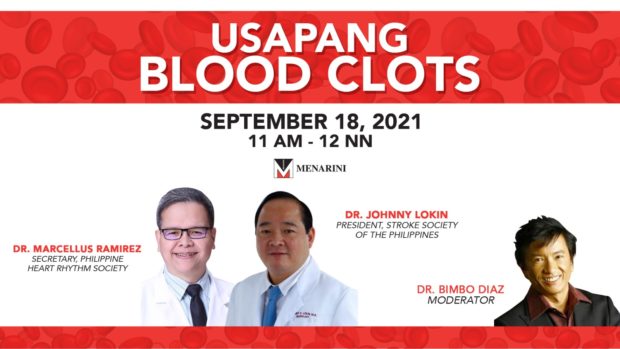COVID-19 is an unprecedented public health emergency that has taken over news headlines and global health agenda. With the spotlight on COVID, non-communicable diseases (NCDs), including heart diseases, stroke, diabetes, cancer, and chronic lung disease, have been deprioritized.
However, it is important to note that NCDs are responsible for causing 71% of all deaths worldwide. With or without a pandemic, these diseases continue to be a threat to many Filipinos. They usually affect people over 70 years old, and are prevalent in low- and middle-income countries.
Committed to empower Filipino patients to be in-charge of their own health, Menarini Asia-Pac held a virtual media forum on thrombosis or blood clots. This effort is in line with company’s initiative to raise awareness among people who are affected by blood clots or who are at increased risk for blood clots.
This virtual forum provides an opportunity to share insights, stories, and, most importantly, to share life-saving information about blood clots on a large and more far-reaching scale.
HOW BLOOD CLOTS CAN CAUSE MORTALITY
Thrombosis, or blood clotting, is a normal body function to prevent excessive bleeding due to a ruptured vein. This happens when platelets mix with a blood plasma protein called “fibrin,” which coagulates blood to form a thin membrane to cover the area of the ruptured vein. Clots usually dissolve overtime as the injured area heals.
However, there would be patients who suffer from irregular heart movements that could abnormally cause clotting and could lead to fatal conditions. These types of clots can travel to important organs and block the normal circulatory flow, thus disrupting their functions. This ‘moving’ blood clot is called embolism, that, if left undetected, could lead to death.
Thrombosis can trigger a series of life-threatening conditions, including heart attack and stroke. A patient can frequently develop blood clots if: they are of old age, pregnant, obese, or smoking. They can also happen to people suffering from hypercoagulability of the blood, has increased estrogen levels, (whether hereditary or due to taking of estrogen-rich contraceptives), experienced severe injuries or trauma to the body, due to surgery, or even cancer. It can also be hereditary.

Dr. Marcellus Ramirez, of the Philippine Heart Rhythm Society, led the discussion about thrombosis and atrial fibrillation–two factors to be considered to detect and prevent the risk of stroke happening to a patient.
The month of September is declared “Atrial Fibrillation (AF) Awareness Month”. This disorder, also discussed by Dr. Ramirez, is a known type of “arrhythmia” or irregular heartbeat. It is caused by uncoordinated pumping of the upper and lower chambers of the heart. To people suffering from AF, clots can happen at the upper chambers. These ‘irregular’ clots can circulate and cause blockage in the veins, and if it reached major arteries of important organs, could lead to heart attack and stroke.
This can develop in patients who are above 70 years old, have a pre-existing heart, kidney, or lung diseases, diabetes, and high blood pressure. Thyroid problems, sleep apnea, and metabolic syndrome can also cause atrial fibrillation.
THE DANGER OF AF-RELATED STROKE
According to the Department of Health, and the Food and Nutrition Research Institute, atrial fibrillation is common among Filipinos over the age of 70 years old. It poses a threat as it puts a patient at a higher risk for stroke. Since clots can happen to people suffering from AF, the deposits can sometimes reach the brain. That is why AF puts them at risk for stroke for about three to five times higher. Dr. Johnny Lokin, of the Stroke Society of the Philippines, discussed how clots can stop the blood flow to your brain and possibly cause a stroke.
Stroke, or “brain attack,” is the third leading cause of death, next to heart diseases and cancer, in the Philippines in 2020, according to the survey conducted by the Philippine Statistics Authority. There were reported 99.7 thousand deaths caused by stroke in the year 2020 alone, which is about a 2.3% jump from 2019, which had 97.5 thousand deaths reported.
Atrial fibrillation creates thrombosis that is pumped to the brain, blocking major arteries that carry oxygenated blood, which is crucial for brain function. It is estimated that one-fourth of all strokes after the age of 40 are caused by AF. This condition is called, “ischemic stroke”.
About 87% of all strokes are ischemic. The brain cells and tissues can die within minutes due to lack of oxygen and nutrients. Since a patient suffers from atrial fibrillation, the clots caused by AF clogs the arteries, thus resulting in fatal brain malfunction.
Thrombotic stroke (stroke via blood clotting) would manifest in one or more “mini-strokes,” called transient ischemic attacks (TIAs). TIAs may last for a few minutes or up to 24 hours, and are often a warning sign that a stroke may occur. Despite this, AF-caused strokes can be prevented by taking anticoagulant (blood-thinning) medication.
After the discussion, a patient is invited to share his experience with stroke.
HOW TO PREVENT STROKE WITH MEDICATION
According to the National Stroke Association, thrombotic stroke is preventable through medication to manage blood clotting. There are two ways to be able to prevent the risk of getting a stroke: through medication adherence and compliance.
Medication adherence, or the taking of medications correctly as prescribed by the doctor, is another integral aspect of blood clots management that many patients usually take for granted. But effective management of blood clots depends on patients’ self-care.
Adherence to medication is a key part of health care and affects all areas. Apart from compliance to medication, it involves following a recommended diet or implementing lifestyle changes that goes along with medical advice. Medication non-adherence in patients leads to substantial worsening of disease, death, and increased health care costs.
Adherence to maintenance medication is a life-saving way as physicians, pharmacists and nurses ensures that the patient has a full prescription of their needed anticoagulants and dutifully takes them on time.
According to the World Health Organization, adherence help improve cases of at-risk patients because both the patient and the physician collaborate to improve the patient’s status by integrating the physician’s medical opinion and the patient’s lifestyle, values and preferences for care.
Physicians are advised to know the capacity of their patient to access the medicines they would need. That includes disclosing their financial ability and their access to a pharmacy at every appointment. Pharmacists should also help by explaining thoroughly to patients their refill programs, assistance, and generic medicine so that they are knowledgeable on their medication. Both doctors and patients can also device tracking systems so that patients will not have a hard time following up and taking their medicine as prescribed.
Thrombotic stroke can be prevented with enough knowledge on its causes and with a thorough medication program to help the body fight off any signs of it.
ADVT


